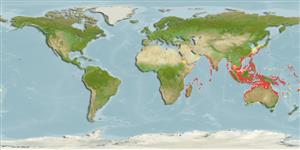Common names from other countries
Environment: milieu / climate zone / depth range / distribution range
Ekologi
Berasosiasi dengan karang; kisaran kedalaman 0 - 70 m (Ref. 800). Tropical
Indo-West Pacific: East Africa to Japan and Australia.
Length at first maturity / Size / Weight / umur
Maturity: Lm ? range ? - ? cm Max length : 2.0 cm WD jantan/; (Ref. 800)
Maximum arm length: 20.0 cm. Occurs among branching corals and in crevices at depths of 0 to 70 m. Feeds by suspension feeding (Ref. 800).
Life cycle and mating behavior
Kematangan | Reproduksi, perkembang biakan | Pemijahan | telur-telur | Fecundity | Larva
Members of the class Ophiuroidea are mostly gonochoric, others are protandric. Fertilization is external. Brooding is common, bursae is used as brood chambers where the embryos develop into juveniles and later crawl out from the bursal slits. Life cycle: Embryos hatch into free-swimming planktotrophic larvae and later metamorphose into tiny brittle stars which sink down the bottom where they grow into adult form.
rujukan utama
Acuan | Koordinator | mitra
Schoppe, S. 2000. (Ref. 800)
Status IUCN Red List (Ref. 130435)
status CITES (Ref. 108899)
Not Evaluated
Not Evaluated
ancaman kepada manusia
Harmless
penggunaan manusia
| FishSource |
Alat, peralatan
informasi lanjut
Umur / Saiz
Pertumbuhan
panjang-berat
panjang-panjang
Morfologi
Larva
Kelimpahan
Sumber internet
Estimates based on models
Preferred temperature
(Ref.
115969): 24.2 - 29, mean 27.7 (based on 896 cells).
keancaman
Low vulnerability (10 of 100).
kategori harga
Unknown.
